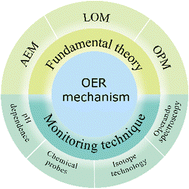Advances in the mechanism investigation for the oxygen evolution reaction: fundamental theory and monitoring techniques
Abstract
Highly active oxygen evolution reaction (OER) electrocatalysts plays a crucial role in efficient water splitting. Understanding the OER mechanism provides the premise for rational catalyst design. Although the conventional adsorbate evolution mechanism (AEM) has been applied widely in OER systems, a comprehensive mechanistic model is still lacking, and some unconventional mechanisms (such as the lattice oxygen mechanism and the oxide path mechanism) have been built newly to account for novel experimental records. Here, to gain insight into the essence of the OER mechanism, including the proposed unconventional ones, we concentrate on the advancement in fundamental principles illustrated by density functional theory as well as direct experimental evidence acquired through ex situ and/or operando techniques (such as pH dependence, chemical probes, isotope technology and operando spectroscopy) in this review. Finally, the challenges and viewpoints of the OER mechanism investigation are addressed. We anticipate that this review will advance the in-depth understanding of the OER mechanism and aid in the rational design of OER catalytic materials.

- This article is part of the themed collections: 2023 Materials Chemistry Frontiers Review-type Articles and 2023 Materials Chemistry Frontiers HOT articles


 Please wait while we load your content...
Please wait while we load your content...